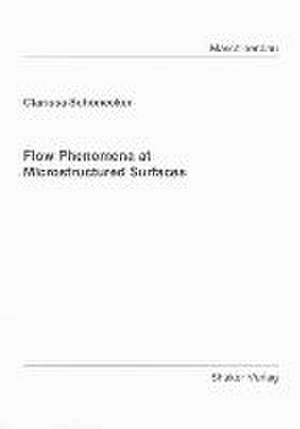Flow Phenomena at Microstructured Surfaces: Berichte aus dem Maschinenbau
Autor Clarissa Schöneckeren Limba Engleză Paperback – 10 dec 2013
Din seria Berichte aus dem Maschinenbau
-
 Preț: 270.51 lei
Preț: 270.51 lei -
 Preț: 281.63 lei
Preț: 281.63 lei -
 Preț: 277.13 lei
Preț: 277.13 lei -
 Preț: 244.20 lei
Preț: 244.20 lei -
 Preț: 245.00 lei
Preț: 245.00 lei -
 Preț: 262.84 lei
Preț: 262.84 lei -
 Preț: 276.03 lei
Preț: 276.03 lei -
 Preț: 279.81 lei
Preț: 279.81 lei -
 Preț: 244.48 lei
Preț: 244.48 lei -
 Preț: 249.92 lei
Preț: 249.92 lei -
 Preț: 245.14 lei
Preț: 245.14 lei -
 Preț: 244.92 lei
Preț: 244.92 lei -
 Preț: 264.73 lei
Preț: 264.73 lei -
 Preț: 263.13 lei
Preț: 263.13 lei -
 Preț: 261.45 lei
Preț: 261.45 lei -
 Preț: 263.78 lei
Preț: 263.78 lei -
 Preț: 263.19 lei
Preț: 263.19 lei -
 Preț: 271.17 lei
Preț: 271.17 lei -
 Preț: 299.05 lei
Preț: 299.05 lei -
 Preț: 245.72 lei
Preț: 245.72 lei -
 Preț: 264.80 lei
Preț: 264.80 lei -
 Preț: 263.28 lei
Preț: 263.28 lei -
 Preț: 261.22 lei
Preț: 261.22 lei -
 Preț: 296.16 lei
Preț: 296.16 lei -
 Preț: 279.74 lei
Preț: 279.74 lei -
 Preț: 245.14 lei
Preț: 245.14 lei -
 Preț: 263.85 lei
Preț: 263.85 lei -
 Preț: 269.57 lei
Preț: 269.57 lei -
 Preț: 270.23 lei
Preț: 270.23 lei -
 Preț: 244.05 lei
Preț: 244.05 lei -
 Preț: 244.05 lei
Preț: 244.05 lei -
 Preț: 281.48 lei
Preț: 281.48 lei -
 Preț: 279.77 lei
Preț: 279.77 lei -
 Preț: 244.27 lei
Preț: 244.27 lei -
 Preț: 303.40 lei
Preț: 303.40 lei -
 Preț: 273.14 lei
Preț: 273.14 lei -
 Preț: 262.69 lei
Preț: 262.69 lei -
 Preț: 259.59 lei
Preț: 259.59 lei -
 Preț: 279.96 lei
Preț: 279.96 lei -
 Preț: 264.22 lei
Preț: 264.22 lei -
 Preț: 86.43 lei
Preț: 86.43 lei -
 Preț: 263.34 lei
Preț: 263.34 lei -
 Preț: 244.70 lei
Preț: 244.70 lei -
 Preț: 243.17 lei
Preț: 243.17 lei -
 Preț: 282.02 lei
Preț: 282.02 lei -
 Preț: 272.62 lei
Preț: 272.62 lei -
 Preț: 282.68 lei
Preț: 282.68 lei -
 Preț: 270.89 lei
Preț: 270.89 lei -
 Preț: 259.56 lei
Preț: 259.56 lei
Preț: 259.82 lei
Nou
Puncte Express: 390
Preț estimativ în valută:
49.72€ • 53.16$ • 41.45£
49.72€ • 53.16$ • 41.45£
Carte indisponibilă temporar
Doresc să fiu notificat când acest titlu va fi disponibil:
Se trimite...
Preluare comenzi: 021 569.72.76
Specificații
ISBN-13: 9783844024401
ISBN-10: 3844024409
Pagini: 132
Ilustrații: 132 farbige Abbildungen
Dimensiuni: 151 x 213 x 9 mm
Greutate: 0.19 kg
Editura: Shaker Verlag
Seria Berichte aus dem Maschinenbau
ISBN-10: 3844024409
Pagini: 132
Ilustrații: 132 farbige Abbildungen
Dimensiuni: 151 x 213 x 9 mm
Greutate: 0.19 kg
Editura: Shaker Verlag
Seria Berichte aus dem Maschinenbau
